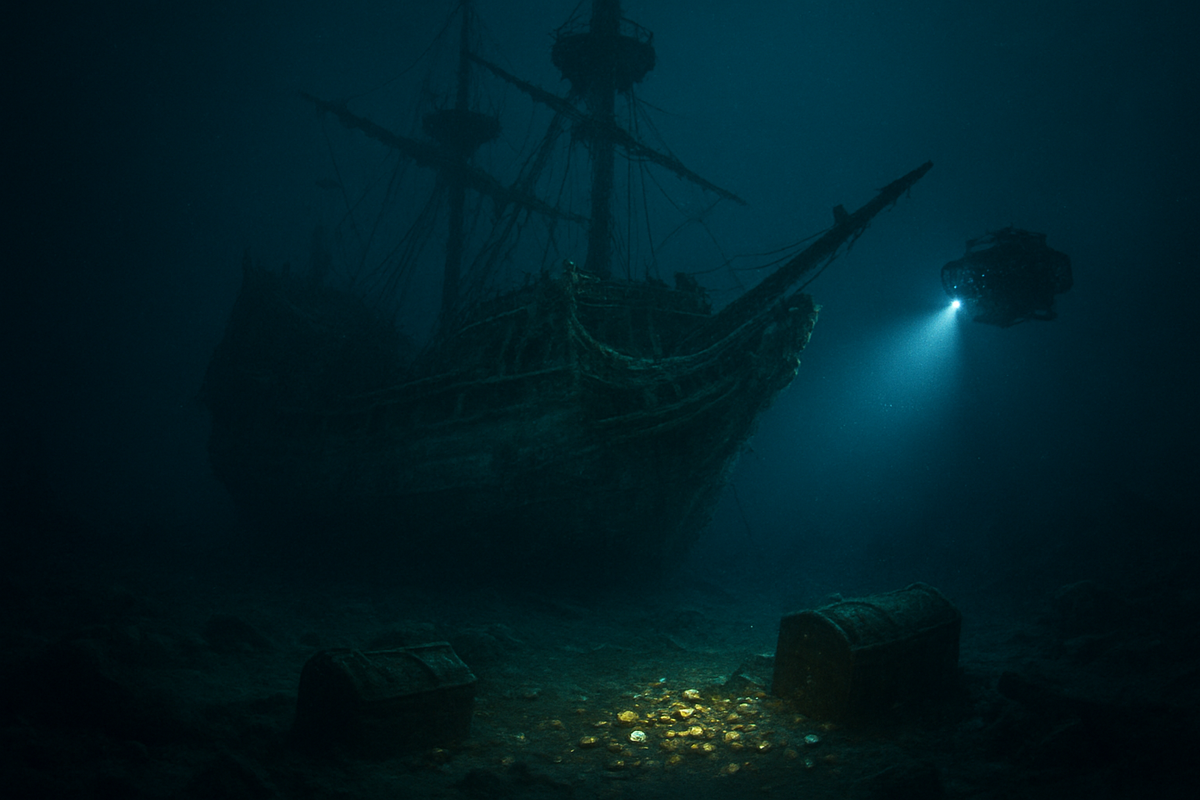
Cartagena, Colombia – November 26, 2025 – The legendary San José galleon, often hailed as the "holy grail of shipwrecks," has once again captured global attention as Colombian scientists successfully recovered the first physical artifacts from its depths earlier this month. Laden with an estimated $17 billion to $20 billion in gold, silver, and emeralds, the 18th-century Spanish vessel represents not only an unparalleled treasure but also a profoundly significant piece of underwater cultural heritage. This monumental recovery effort, conducted between November 16 and 18, 2025, marks a pivotal moment in the ongoing saga surrounding the sunken galleon, intensifying both scientific interest and the intricate legal battles over its ownership.
The recent retrieval of items including a bronze cannon, three hammered gold coins, and a porcelain cup underscores Colombia's commitment to a scientific and archaeological approach, rather than purely commercial salvage. While the world watches with bated breath, the implications of this discovery ripple through international law, heritage preservation, and potentially, the rare artifacts market. The immediate focus is on the meticulous conservation of these initial finds, which are now undergoing study in a dedicated laboratory, offering a tantalizing glimpse into the vast riches and historical narratives still preserved within the wreck.
The Galleon's Grand Unveiling: A Timeline of Discovery and Dispute
The story of the San José is one steeped in naval history, colonial wealth, and a modern-day quest for its elusive riches. The 64-gun Spanish galleon met its tragic end on June 8, 1708, during the War of the Spanish Succession, when it was ambushed by a British squadron near Cartagena, Colombia. Carrying an immense cargo of 11 million gold and silver coins, emeralds, and other precious items from Spanish-controlled Latin American colonies, the ship was en route to Spain to fund the crown's war efforts when it sank, taking most of its 600-person crew to a watery grave at a depth of 600 meters.
For centuries, the San José remained lost, its legend growing with each passing year. While a U.S. salvage company, Sea Search Armada (SSA), claims to have discovered the wreck in 1982, it was the Colombian Navy that officially located the galleon in November 2015, using an autonomous underwater vehicle (AUV). The exact coordinates of the site have since been a closely guarded state secret, a measure taken to protect the site from unauthorized interventions. The government of President Gustavo Petro has unequivocally stated that its deep-water expedition, dubbed "Towards the Heart of the San José Galleon," is primarily for scientific research and to study the wreckage, moving beyond the traditional narrative of treasure hunting.
The current phase of recovery and research gained significant momentum throughout 2024, with remotely operated vehicles conducting extensive surveys that mapped additional treasures and identified over 1,100 artifacts, including anchors, jugs, and glass bottles. A study published in the journal Antiquity in June 2025 further confirmed the provenance of specific gold coins found near the wreck. The successful recovery of the first physical artifacts between November 16 and 18, 2025, represents the culmination of these efforts, with items like the "Sevilla"-inscribed bronze cannon and "macuquina" gold coins now providing tangible links to the past. This scientific approach has even led to new theories regarding the ship's sinking, with authorities now considering hull damage as a possibility alongside the long-held belief of an explosion.
However, this scientific endeavor is inextricably linked to complex and ongoing legal and diplomatic disputes over ownership. Colombia asserts the wreck as part of its national cultural heritage, discovered within its waters. Spain, conversely, argues that as a state naval vessel, the San José and its contents remain Spanish property under international maritime law. Meanwhile, Sea Search Armada (SSA) continues its pursuit of a 50% share of the treasure, claiming a $10 billion entitlement based on their alleged 1982 discovery and a prior agreement with the Colombian government—a claim Colombia vehemently disputes. Adding another layer of complexity, descendants of Indigenous Qhara Qhara Bolivians and Peruvian miners have also sought a share, contending that much of the treasure was plundered from their ancestral lands. These disputes are currently being addressed, most notably through arbitration proceedings at the Permanent Court of Arbitration in The Hague, with a ruling on SSA's $10 billion claim anticipated by the end of 2025. The immense value and contested ownership led UNESCO to issue a call in 2018 for Colombia not to commercially exploit the wreck, underscoring its cultural significance.
Market Ripples: Who Wins and Who Loses from the San José's Emergence
The immense wealth of the San José, while primarily viewed through the lens of cultural heritage by Colombia, inevitably casts a long shadow over various economic sectors. While the sheer volume of gold, silver, and emeralds is unlikely to significantly disrupt global commodity markets, the specialized nature of the recovered items and the high-stakes recovery efforts create distinct opportunities and challenges for a range of public companies and industries.
In the realm of precious metals and gemstones, the direct impact on global spot prices for gold and silver is expected to be minimal. The estimated 11 million gold and silver coins and 200 tons of precious metals, though substantial in value, represent a fraction of the world's annual production and above-ground supply. However, the discovery could subtly reinforce the "safe haven" appeal of precious metals and ignite interest in niche markets. High-end auction houses like Sotheby's (NYSE: BID) could see a boost in demand for rare coins and historical artifacts, potentially benefiting from the eventual sale of any non-heritage designated items. Similarly, specialized numismatic dealers and firms dealing in physical bullion and rare coins might experience increased interest as the narrative underscores the enduring value of these assets. For emeralds, the situation is analogous; while the San José's gemstones are historically invaluable, they are unlikely to flood the modern market and depress prices for newly mined stones. Instead, they would command premium prices in the collector's market, again positioning high-end auctioneers and specialized gemstone appraisers as potential beneficiaries. No significant public company losers are anticipated in the broader precious metals or gemstone mining sectors due to this specific find.
The technological demands of deep-sea exploration and recovery present a clear advantage for companies operating in the marine technology sector. The San José lies at a challenging depth of 600 meters, necessitating advanced Remotely Operated Vehicles (ROVs), Autonomous Underwater Vehicles (AUVs), and sophisticated subsea systems. While many key players in this highly specialized field are private, publicly traded entities with relevant expertise stand to benefit. Teledyne Technologies Inc. (NYSE: TDY), with its marine instrumentation and AUVs, and Kongsberg Gruppen ASA (OSE: KOG), known for its advanced maritime robotics and hydroacoustic systems, are examples of companies whose technologies are crucial for such operations. Similarly, Fugro N.V. (AMS: FUR), a global leader in geo-intelligence and marine surveys, could see increased demand for its specialized vessels and remote sensing equipment. Even companies like The Metals Company (NASDAQ: TMC), primarily focused on deep-sea mining, could benefit from the spillover in technological advancements and demand for deep-sea exploration tools.
Beyond the hardware, the complex legal and cultural heritage aspects of the San José shipwreck create a unique landscape for professional services. Law firms specializing in international maritime and cultural heritage law, such as those representing the Colombian government or entities like Sea Search Armada, are already deeply involved in the extensive arbitration proceedings, enhancing their reputation and future business. Furthermore, cultural heritage consulting firms like TRC Companies (NYSE: TRC), which provide archaeological services and compliance reporting, could play a significant role in assisting governments and stakeholders in navigating the intricate cultural heritage aspects of the recovery, from conservation planning to exhibition strategies. Conversely, private salvage companies like Sea Search Armada, whose business model often relies on a share of recovered treasure, face substantial potential losses. If Colombia's cultural heritage claim prevails in international arbitration, SSA stands to lose its claimed $10 billion, significantly impacting its operations and future prospects in the high-risk salvage industry.
A Global Flashpoint: Broader Implications for Underwater Cultural Heritage
The saga of the San José extends far beyond the immediate thrill of its treasure, serving as a pivotal case study that illuminates profound tensions in marine archaeology, international law, and cultural heritage preservation. Its emergence at a time of advanced deep-sea technology forces a critical re-evaluation of how humanity approaches the exploration and ownership of submerged historical sites.
One of the most significant ripple effects is the intensified debate between commercial salvage operations and the principles of scientific marine archaeology. For decades, the allure of sunken treasure has driven "treasure hunters," often at odds with archaeologists who advocate for in situ preservation or meticulous excavation to protect invaluable historical data. The San José, a war grave where nearly 600 lives were lost, underscores the ethical dimension of disturbing such sites. Colombia's deliberate shift towards a scientific investigation, emphasizing the wreck as a "submerged capsule of history" rather than a mere repository of wealth, sets a powerful precedent. This approach, prioritizing cultural value, historical insights into colonial economics, and cross-cultural exchanges, could reshape future governmental strategies regarding high-value shipwrecks, potentially diminishing the role of purely commercial salvage in favor of academic and governmental partnerships.
The complex web of claimants—Colombia, Spain, Sea Search Armada (SSA), and indigenous groups from Bolivia, Peru, and Panama—highlights the ambiguities and gaps in international maritime law concerning underwater cultural heritage. Neither the United Nations Convention on the Law of the Sea (UNCLOS) nor the UNESCO Convention on the Protection of Underwater Cultural Heritage (CPUCH) provides definitive answers for ownership in such multifaceted disputes. Colombia's 2013 legislation, which declares culturally important objects in its waters as national property, directly challenges Spain's traditional claim of sovereign immunity over its sunken warship, creating a legal battleground that tests the boundaries between a coastal state's jurisdiction and the flag state principle. The ongoing arbitration at The Hague, with a ruling on SSA's $10 billion claim expected by year-end, will undoubtedly set a significant precedent for how future disputes involving sovereign wrecks and commercial salvors are resolved globally, potentially deterring private-sector investment in purely commercial operations if nationalization claims become more prevalent.
Historically, the San José draws comparisons to other high-value shipwreck discoveries, each with its own contentious outcome. The Nuestra Señora de Atocha, discovered by Mel Fisher in 1985, became a commercially salvaged treasure, resulting in a protracted legal battle that Fisher ultimately won against the state of Florida. Conversely, the Nuestra Señora de las Mercedes, salvaged by Odyssey Marine Exploration, saw Spain successfully argue in U.S. courts that the frigate was a sovereign vessel, leading to the return of the treasure to Spain. This latter case strengthens Spain's position regarding the San José. The meticulous archaeological recovery and public display of the Tudor warship Mary Rose in 1982, without commercial exploitation, stands as an exemplar of the scientific approach that Colombia now champions. The San José, therefore, is not merely a treasure hunt; it is a global flashpoint that will influence regulatory frameworks, ethical considerations, and the very future of how humanity interacts with its submerged past.
What Lies Ahead: Uncharted Waters for the San José
The future of the San José galleon is poised at the intersection of scientific ambition, international diplomacy, and the formidable challenges of deep-sea recovery. As Colombia solidifies its stance on the wreck as an invaluable piece of cultural heritage, the coming months and years will dictate not only the fate of its billions in treasure but also set a global precedent for underwater archaeology.
In the short term, Colombia's immediate focus remains on meticulous scientific investigation and conservation. The successful recovery of initial artifacts in mid-November 2025—a bronze cannon, gold coins, and a porcelain cup—marks the beginning of a multi-phase research project designed to unearth historical insights into 18th-century life and trade, rather than immediate commercial exploitation. Further expeditions are slated for 2025 and 2026, signaling a sustained commitment to this archaeological endeavor. Crucially, the outcome of the ongoing arbitration between Colombia and Sea Search Armada at the Permanent Court of Arbitration in The Hague, with hearings held from November 25 to December 3, 2025, will be a defining moment. This ruling will significantly influence future access to and management of the wreck, potentially clarifying the rights of commercial salvors versus national sovereignty claims.
Looking further ahead, Colombia envisions a grand long-term plan centered on cultural preservation. This includes the establishment of a state-of-the-art museum of shipwrecks in Cartagena, where recovered artifacts would be meticulously conserved and displayed. The ambitious goal of eventually raising portions of, or even the entire vessel, for exhibition mirrors projects like the Vasa in Sweden, aiming to transform the San José into a premier cultural tourism attraction. This strategic pivot from a "treasure hunt" to a cultural beacon necessitates continued investment in deep-sea archaeology and advanced conservation science, potentially through innovative public-private partnerships. Stakeholders like Sea Search Armada may need to adapt their strategies, potentially seeking settlements or collaborative ventures that align with Colombia's cultural objectives if their commercial claims are not fully recognized. Spain, too, might pivot from a sole ownership claim to advocating for shared cultural management or collaborative archaeological projects, especially if international legal opinions lean towards Colombia's territorial sovereignty. Indigenous communities, asserting historical claims over the treasure, will continue their advocacy to ensure their voices are heard and potentially integrated into any future disposition plans.
The emerging market opportunities are primarily concentrated in cultural tourism and technological innovation. A dedicated museum and world-class exhibitions could attract global visitors, providing a substantial economic boost for Cartagena and diversifying Colombia's economy through cultural industries. The extreme technical demands of deep-sea recovery and preservation will continue to push the boundaries of underwater robotics, conservation science, and maritime archaeology, fostering innovation that could benefit companies like Teledyne Technologies Inc. (NYSE: TDY) and Kongsberg Gruppen ASA (OSE: KOG). However, significant challenges persist, including the immense costs and technical difficulties of recovering and conserving artifacts from such depths, the need for stringent security to protect the site, and the ongoing ethical debates surrounding commercial exploitation versus archaeological preservation. The outcome of the legal disputes, particularly the PCA arbitration, will set critical precedents for future claims over other historically significant deep-sea wrecks, shaping the landscape for all involved in underwater cultural heritage.
The San José: A Legacy Beyond Gold
The San José shipwreck, a relic of the 18th century, has transcended its identity as a mere treasure chest to become a profound symbol of cultural heritage, legal complexity, and the evolving ethics of marine archaeology. Its story, punctuated by the recent recovery of initial artifacts in November 2025, is a testament to both the enduring allure of sunken riches and the growing global imperative to preserve our shared underwater past. The saga of this Spanish galleon, laden with an estimated $17 billion to $20 billion in gold, silver, and emeralds, is far from over, but its trajectory has irrevocably shifted from a purely commercial endeavor to a scientific and cultural mission.
Moving forward, the "market" surrounding the San José is less about direct commodity trading and more about specialized services and cultural investment. Colombia's resolute declaration of the wreck as "assets of national cultural interest" fundamentally redefines its value, emphasizing archaeological and cultural preservation over commercial exploitation. This creates a unique ecosystem of opportunities in advanced deep-sea robotics, conservation science, and museum development, rather than a traditional market for selling recovered artifacts. While the immense estimated value of the cargo ensures that underlying commercial interests and legal claims will continue to exert influence, the prevailing narrative is now firmly rooted in heritage stewardship.
The lasting impact of the San José will resonate across historical, cultural, and legal domains. As an invaluable underwater time capsule, it offers unparalleled insights into 18th-century European economics, colonial trade networks, and naval warfare. For Colombia, the wreck is a cornerstone of national identity and maritime heritage, with the planned museum in Cartagena poised to educate and inspire. Crucially, the ongoing legal disputes, particularly the arbitration between Colombia and Sea Search Armada at The Hague, are setting significant precedents in international maritime law. The outcome will shape how future discoveries of sovereign and historically significant wrecks are managed globally, balancing the rights of coastal states, flag states, indigenous communities, and commercial entities.
Investors keen on the deep-sea sector or those with an interest in cultural heritage should closely monitor several key developments in the coming months. The rulings from the Permanent Court of Arbitration regarding Sea Search Armada's substantial claim will be paramount, defining the boundaries of commercial salvage versus national patrimony. Furthermore, vigilance should be maintained over Colombia's long-term plans and funding for the San José project. Updates on the pace and scope of recovery and conservation efforts, details on the timeline and funding for the proposed Cartagena museum, and any potential public-private partnerships will signal Colombia's commitment to its cultural heritage strategy. While President Gustavo Petro's administration has hinted at collaborative teams for the mission, any such opportunities would likely be in logistical, technological, or conservation support, not in the direct commercial exploitation of the treasure itself. In essence, the San José has transformed from a treasure hunter's dream into a complex archaeological, cultural, and legal undertaking, with Colombia firmly prioritizing national heritage and scientific study over immediate financial gain.
This content is intended for informational purposes only and is not financial advice





